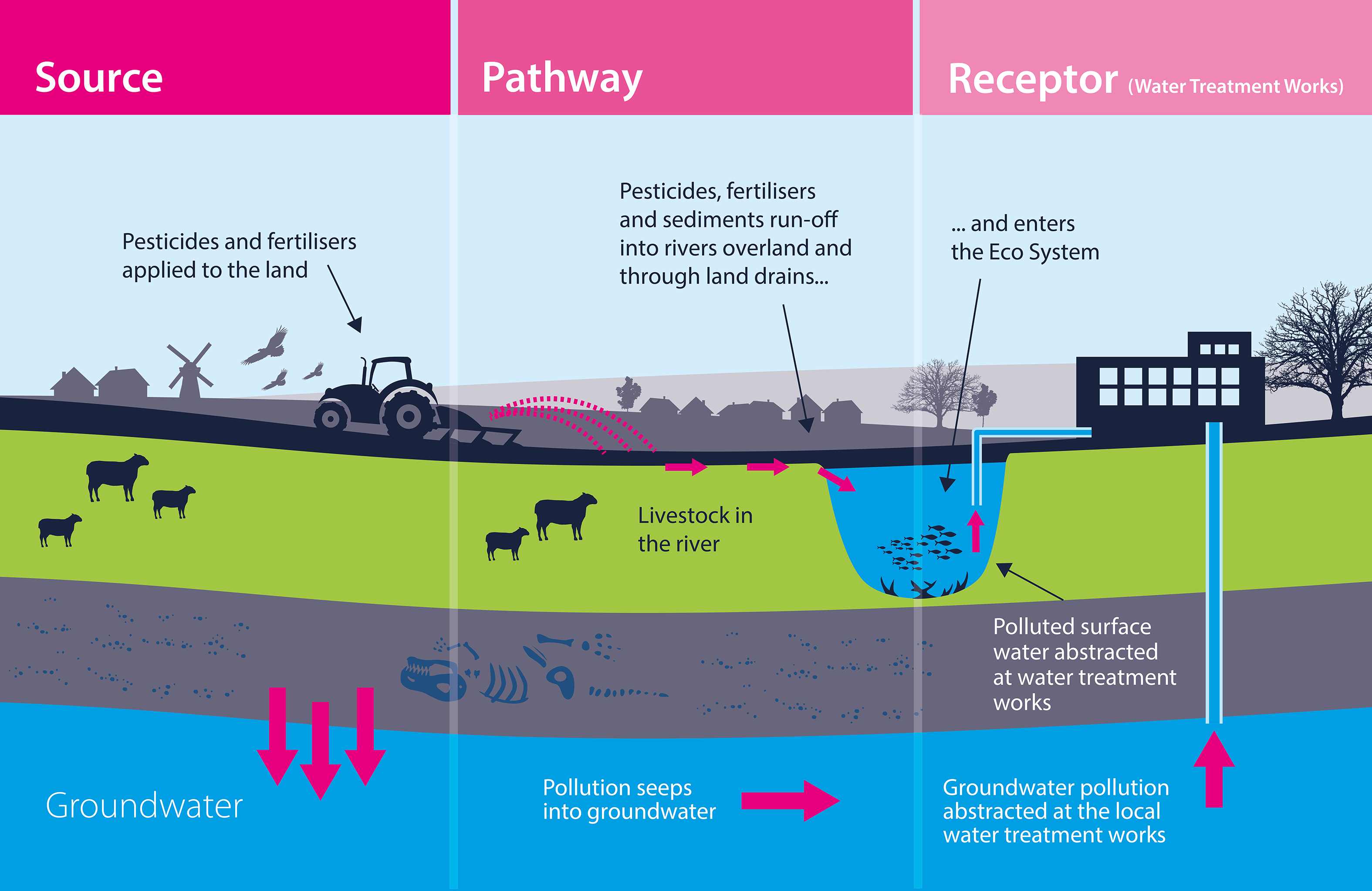We are committed to providing a consistent supply of high-quality water to all of our customers now and for the future.
In a catchment, rainfall that is not used by plants either infiltrates into the aquifer to become groundwater or continues on the surface as runoff, eventually flowing into surface water systems such as streams, rivers and lakes.
A catchment is a defined area of natural landscape that collects precipitation and contributes to a body of water, such as an aquifer or river.
The quality of this water can be affected by activity which takes place on the land and rivers that make up the catchment area.
Agriculture, industry, waste management and water abstraction all have an impact on the catchment and the quality of the water within it.
An Overview: The Source, Pathway, Receptor Model
 The catchment approach works on the model of source, pathway and receptor.
The catchment approach works on the model of source, pathway and receptor.
This model displays how contaminants can reach our sources and provides a method of managing these risks. By understanding and tackling problems at the source we can reduce our reliance on ‘end of pipe’ treatment solutions.
Our Catchment
What's the quality of raw water like in the Cambridge region?
Our drinking water is taken from chalk aquifers that lie to the South and East of Cambridge. The chalk layers naturally filter the water from certain contaminants and impurities, this results in high quality raw water that requires very little treatment.
Nitrogen is an essential nutrient for plant growth and is regularly applied to agricultural land as nitrate in fertilisers. Agricultural fertilisers can leach into groundwater and run-off into surface water, influencing water quality.
Historically, our approach has been to ‘blend’ water from different sources. This involves mixing water that has higher concentrations of nitrate with water that has lower concentrations to ensure all water meets the required standards. Where this is not possible, we treat the water at nitrate treatment plants.
However, due to many factors in the catchment, we have seen rising nitrate concentrations in the aquifers over the years which, compromises the quality of our drinking water supply. One of these factors is agriculture, so we are currently working with farmers in our catchments to try to reduce future nitrate concentrations and reduce the risk of any other water quality issues, such as pesticides.
What are our long-term goals for managing the quality of raw water?
We have previously relied on ‘blending’ raw water to adhere to nitrate limits but unfortunately our ‘low-nitrogen’ water is becoming too high to blend the higher concentration water to an acceptable level. Therefore, we have had to invest in ‘end of pipe’ treatments at some sources.
Our approach is to combine treatment in the short to medium term with a wider catchment approach aimed at improved land management for the long term.
We aim to rely less on ‘end of pipe’ treatment solutions and more on catchment management to improve the quality of our water.
Tackling problems at the source improves resilience for the future and allows us to be proactive rather than reactive.
This approach is not only more cost-effective and sustainable but also delivers greater benefits to the environment and our customers.
Catchment management can also provide improved control over challenging chemicals that pose difficulties for treatment works by addressing these substances at their source and along their pathways.
How are we going to achieve this?
It is all about risk identification and then working with external and internal stakeholders to reduce those risks. For more information, download our catchment management leaflet
If you are interested in finding out more about catchment management at Cambridge Water, please email the catchment management team
Useful links
A guide to best practice in the catchment.
A map of Cambridge source catchments.
A map of the Euston and Brettenham catchments.
A map of the Fowlmere catchment.
A map of the Fleam Dyke catchment.
A map of the Linton, Melbourn and Morden Grange catchments.